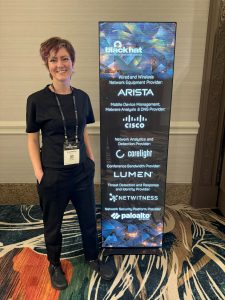 On the primary evening of BlackHat USA, I made dialog with a number of pleasant penetration testers who have been perplexed once I advised them I used to be a developer.
On the primary evening of BlackHat USA, I made dialog with a number of pleasant penetration testers who have been perplexed once I advised them I used to be a developer.
Why would I be at a cybersecurity convention?
…What was I hoping to get out of it?
My basic (and maybe obscure) response to them, and to others I’d meet who can be perplexed by my attendance at each BlackHat and DefCon, was that I needed a greater cybersecurity schooling, notably round AI improvement.
Regardless of my conviction, I admittedly felt a bit misplaced. Safety conferences like BlackHat and DefCon are sometimes seen because the area of penetration testers, safety analysts, and moral hackers, amongst others. Each cybersecurity conferences are revered in their very own proper. And at each, I met good engineers, thought-provoking audio system, and world-renowned researchers.
Not one of the people I met, nonetheless, have been builders.
Having attended each of those occasions for the primary time, I can communicate from expertise once I say that builders have rather a lot to achieve from attending a cybersecurity convention. Listed below are 5 compelling explanation why builders ought to take into account making cybersecurity conferences part of their skilled improvement:
As talked about in a number of talks at BlackHat — the builders and the safety professionals sit in two completely different camps, they usually don’t intermingle as a lot as they need to.
However innovation and safety are completely intertwined, no matter job description or organizational divisions, and this arguably begins on the code-level. The adoption of Shift Left has put extra emphasis on guaranteeing code high quality and safety early within the software program improvement lifecycle; however a want to supply safe code isn’t the identical as figuring out how.
Coaching — or consciousness of coaching — is definitely a contributor. Simply over half of software program builders surveyed by The Linux Basis and OpenSSF reported that they’d by no means taken a course on safe software program improvement, partly as a result of they have been unaware of a great course (although, not having the time was an equally main motive). This lack of information and coaching may be one clarification for why 71% of organizations have safety debt, with 46% of those organizations being deemed to have “crucial” safety debt.
Why would a corporation make time to deal with its safety debt except it understood its criticality?
Or worse, if they’re unaware they’ve it within the first place?
(This was additionally a part of the inspiration for my Cisco DevNet podcast, The DevSec Voice. The present goals to bridge the hole between builders and the cybersecurity neighborhood.)
Should you dive into articles and documentaries on main cybersecurity scandals of the 90s and 00s, you’ll discover a recurring theme: individuals simply weren’t serious about cybersecurity again then.
However I’ll be sincere: I graduated with a Grasp of Software program Engineering in 2021, and on the time, safety was nonetheless hardly even an afterthought — not to mention emphasised.
And I’m not alone on this. Whereas the statistics on builders who really feel assured writing safe code appear to differ extensively, in line with The State of Developer-Pushed Safety Survey (performed by Evans Information Corp for Safe Code Warrior), solely 35% of builders take into account their groups to have “wonderful proficiency” in writing vulnerability-free code.
Having a sensible understanding of the right way to write code free from vulnerabilities may also help cut back that safety debt I discussed above.
Whenever you attend a cybersecurity convention, you not solely start to study sensible code safety by means of DevSec/AppSec talks — you additionally start to domesticate a security-minded improvement stream.
If cybersecurity threats are ever-evolving, so ought to our mitigation methods and safety practices. Generative AI (GenAI) was an enormous subject of curiosity at BlackHat this yr, partly as a result of as shortly as GenAI and associated tooling is being produced, we’ve hardly scratched the floor of safety finest apply requirements or novel assault discovery. Builders and different engineers concerned in GenAI have an moral duty to grasp the safety and privateness dangers of the GenAI they’re creating and supporting.
DefCon has rather a lot to supply, however one of many highlights for me as a first-time attendee was positively the Villages. There are a number of completely different cybersecurity “Villages” starting from AI safety to social engineering to biohacking, through which guests can take part in hands-on actions. As an example, the AI Safety Village allowed you to create your individual deepfake, and I attempted my hand at LLM purple teaming by means of a Seize the Flag (CTF)-style expertise.
What’s finest apply is usually not actuality. Builders can work lengthy hours and underneath immense quantities of stress, and whereas most builders I do know delight themselves on producing prime quality code, there may be quite a few obstacles to doing that.
By having builders on the (metaphorical) cybersecurity desk, we may also help the cybersecurity trade know what builders must persistently produce safe code. This might imply that we now have improved DevSec/AppSec speak monitor illustration; or that we encourage the event of safety instruments and processes that make our lives simpler as a substitute of inducing burnout.
And most necessary of all?
A sensible cybersecurity schooling empowers us to confidently create impactful purposes, staying true to what impressed us to turn out to be builders within the first place.
Subscribe to our YouTube channel to be notified of episodes from our new podcast, The DevSec Voice. The present goals to bridge the hole between builders and the cybersecurity neighborhood by means of laid-back and insightful dialog.
Share:
